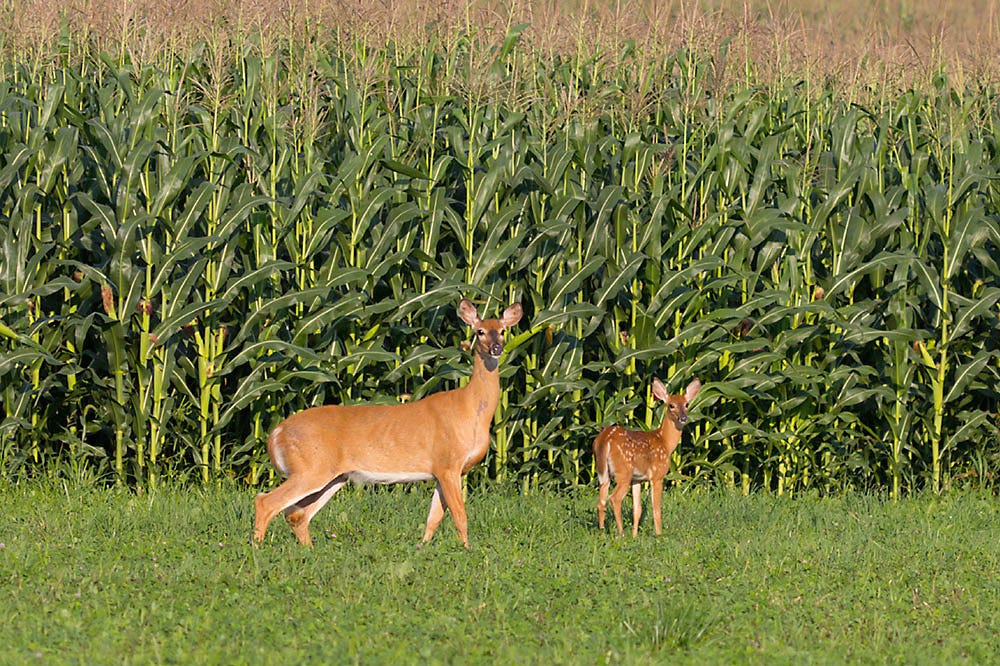Electric Fence for Deer and Elk

Non-domesticated animals, like deer and elk, can be a challenge to contain. Remember they are wild animals and not conditioned to human contact.
Deer and elk tend to range over wide areas to forage. Their travel is motivated by these food sources. Deer and elk can jump higher than most other animals. They spook easily and may exhibit excitable behaviors, which when nervous or scared, may lead to them running without noticing fence lines.
Unfamiliar unexpected sounds, such as dogs barking or traffic, can stress deer and elk. In addition, these animals are prone to predator attacks.
For these reasons, deer and elk need fencing which provides both a physical and psychological barrier.
Woven wire deer fence is common fencing material chosen for this purpose and can be electrified with modifications. Woven wire specifically designed for deer farms will be constructed of high-quality 12.5 gauge high-tensile wire with one-vertical wires notched at each intersection point using a "fixed-knot" design. This knot design holds the wires in place securely and provides rigidity. In addition, the woven wire fencing should feature a graduated spacing to provide greater security along the fence's bottom.
The minimum height recommended for woven wire deer fences is 15 feet high. In-line fence posts should be set into the ground 3 to 4 feet deep, with corner bracing posts set even deeper. Only the highest quality materials should be used.
Electrified high-tensile fence can also be a great choice for elk and deer because it is durable and secure, can be constructed tall, and serves to keep predators out. Electrified high-tensile fencing is an excellent choice for a permanent perimeter fence. These affordable, easy to install, low-maintenance fences can last up to 40 years and are the best solution for deer and elk control.
The wire and spring system of a high-tensile fence allow it to flex and return to its original shape if it is run into, making it optimal for deer and elk.
Many variations in high-tensile fencing design for deer exist. Whatever design is chosen, wire spacing should be close enough to prevent the animal from stepping through or putting its head between the wires. Attach 7 to 9 wire strands to posts that stand at least 70 inches above ground. Be sure that wires are placed near the nose level of the animal. To prevent jumping, an electrified top wire above the deer or elk’s head is recommended. In dry, rocky or frozen ground, you may need to install a ground wire return system.
Deer and elk require a fence charger that can maintain 4,000 – 5,000 volts on the fence line. Voltage levels are impacted by vegetation on the fence line, length of fence, and diameter of wire. Use a low impedance fence charger.
Note: Due to the fencing height requirements and special materials needed to construct deer fencing, consulting a fencing contractor is highly recommended.
Fencing to Exclude Deer and Elk
Deer can pose a nuisance to homeowners' landscaping and gardens. While excluding deer from your yard does present some unique challenges, it can be done.
Deer often move quickly from one feeding area to another and frequently run through electric fences without even seeing them.
The first step in successfully keeping deer out is to put up a sturdy and highly visible fence. In most instances this means a 6-foot tall, permanent high-tensile electrified fence.
Use peanut butter or molasses on a pie tin to bait the fence and attract deer to slow down. The bait will prompt deer to touch the fence with their nose or tongue, receiving a safe but intense shock.
A shock in front of the eyes can cause the deer to back up and leave the area. After one or two encounters with an electric fence, deer will begin looking for other sources of food.
If a permanent high-tensile fence is not an option for you, another possible solution is to use 7-foot T-posts with 7 strands of poly wire or poly tape, spaced 10 inches apart. Use a low impedance fence charger that produces 4,000 to 5,000 volts on the fence.
Note: In some circumstances, electric fencing will not be effective in deterring deer. Ingenious animals will sometimes figure out ways to get through. In addition, the wild animal's drive to get to a food source can sometimes is stronger than their fear of a psychological barrier such as electric fencing.
